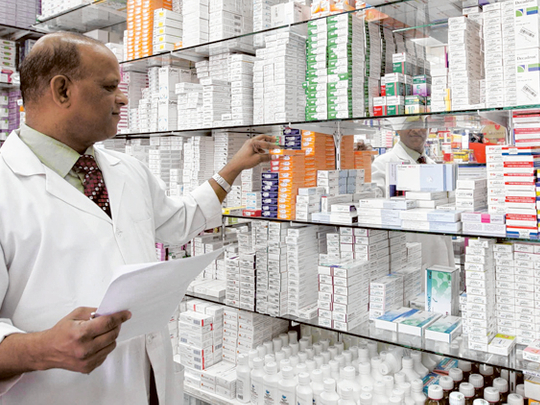
Dubai: Pharmacy chains are turning beneficiaries from Dubai’s move to bring in compulsory health insurance for all in the emirate.
“The footfall at pharmacies has gone up since the start of the year, by well over 10 per cent in most cases,” said Dr Azad Moopen, chairman of Aster DM Healthcare, which operates the ‘Aster’ branded pharmacy network in the UAE. “What is happening is that more residents are coming under health coverage even though many of the provisions of Dubai’s health insurance regulations are still months away from becoming de facto requirements.
“This is because businesses licensed in Dubai are speeding up the process of bringing their full workforce into the coverage mode; that in turn has prompted more visits to clinics or hospitals and led to more sales getting generated at local pharmacies.”
Sources at other pharmacy operators confirm that double-digit growth in footfall has been happening, irrespective of where an outlet is located.
The situation now is a complete contrast to pharmacies’ earlier concerns over their margins following some landmark decisions by the local health authorities. Recently, the retail prices of several medicines were cut, and in the case of drugs for chronic illnesses such as diabetes, cardiovascular ailments and bronchial asthma, the cuts where anywhere between 10-15 per cent. On some medications, the price cut was steeper by even 20 per cent.
“It was only in the last six months that the across-the-board cut on retail medicine prices came into full force,” said Moopen. “It had an effect on margins plus there were the changes brought about by the mandatory health insurance requirements.”
One key change — and that has been in effect for two months now — is that all pharmacy outlets have to get immediate online clearance from the insurer on the prescribed medicines before they can do the billing. What this meant is that physicians are compelled to prescribe only the needed drugs and “only the absolutely necessary investigations” for their patients. (Previously, insurance approvals were done manually and insurers’ checks, if any, came in only much later.)
The combination of lower medicine prices and more thorough vetting of prescriptions mean that the yield per visit for a pharmacy may have come down. But this has been more than compensated by more people turning up with their prescriptions as more of them get insurance coverage from their employers.
“The law is in place but the mandatory scheme has not been practised so far and is expected to go live in the next couple of weeks,” said Gulam Mohammad Teli, chief officer for health and life at AXA Insurance. “We do not expect a drop in claim costs at this stage and it needs time for all relevant stakeholders to adopt to the new system.”
There are other ways pharmacies look to benefit from mandatory health insurance. With more people getting covered, they will have less inclination to source their medicine supplies from lower retail priced markets such as India. Instead, those will accrue to pharmacies here itself.
Moreover, “Mandatory insurance empowers pharmacists to dispense the available brand of choice from the list of approved insured brands, thus encouraging generic pharmaceutical product sales,” said Dr. Shamsheer Vayalil, managing director at VPS Healthcare. “The trend of increased prescribing of generic medications, however, had an impact on price-driven growth [for pharmacies]. But overall growth of retail sales has been on the upswing as compared to the pre-mandatory insurance era.
“[In Abu Dhabi], the implementation of compulsory insurance law in the last six years has had quite an impact on sales of pharmaceuticals across therapeutic categories through retail pharmacies. This is predominantly because mandatory insurance plan has led to increased number of patients visiting the health care facilities and doctors. These factors have led to increase in volumes on an average by 10-15 per cent year-on-year.”












